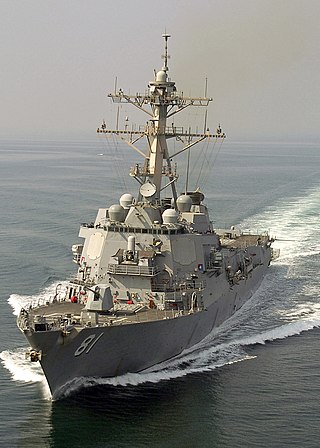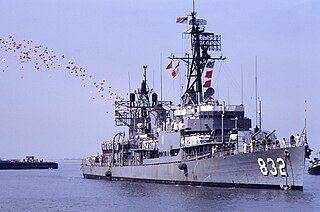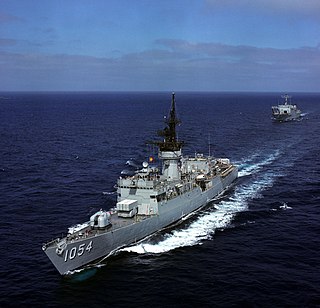
The RUR-5 ASROC is an all-weather, all sea-conditions anti-submarine missile system. Developed by the United States Navy in the 1950s, it was deployed in the 1960s, updated in the 1990s, and eventually installed on over 200 USN surface ships, specifically cruisers, destroyers, and frigates. The ASROC has been deployed on scores of warships of many other navies, including Canada, Germany, Italy, Japan, the Republic of China, Greece, Pakistan and others.

In naval terminology, a destroyer is a fast, manoeuvrable, long-endurance warship intended to escort larger vessels in a fleet, convoy, or battle group and defend them against powerful short-range attackers. They were originally developed in 1885 by Fernando Villaamil for the Spanish Navy as a defense against torpedo boats, and by the time of the Russo-Japanese War in 1904, these "torpedo boat destroyers" (TBDs) were "large, swift, and powerfully armed torpedo boats designed to destroy other torpedo boats". Although the term "destroyer" had been used interchangeably with "TBD" and "torpedo boat destroyer" by navies since 1892, the term "torpedo boat destroyer" had been generally shortened to simply "destroyer" by nearly all navies by the First World War.

The 18 Forrest Sherman-class destroyers comprised the first post-war class of US destroyers. Commissioned beginning in 1955, these ships served until the late 1980s. Their weaponry underwent considerable modification during their years of service. Four were converted to guided-missile destroyers. This class also served as the basis for the Charles F. Adams-class guided-missile destroyers.

The 46 Knox-class frigates were the largest, last, and most numerous of the US Navy's second-generation anti-submarine warfare (ASW) escorts. Originally laid down as ocean escorts, they were all redesignated as frigates on 30 June 1975, in the 1975 ship reclassification plan and their hull designation changed from 'DE' to 'FF'. The Knox class was the Navy's last destroyer-type design with a steam turbine powerplant.

The Gearing class was a series of 98 destroyers built for the U.S. Navy during and shortly after World War II. The Gearing design was a minor modification of the Allen M. Sumner class, whereby the hull was lengthened by 14 ft (4.3 m) at amidships, which resulted in more fuel storage space and increased the operating range.

The Allen M. Sumner class was a group of 58 destroyers built by the United States during World War II. Another twelve ships were completed as destroyer minelayers. The class was named for Allen Melancthon Sumner, an officer in the United States Marine Corps. Often referred to as simply the Sumner, this class was distinguished from the previous Fletcher class by their twin 5-inch/38 caliber gun mounts, dual rudders, additional anti-aircraft weapons, and many other advancements. The Allen M. Sumner design was extended 14 feet (4.3 m) amidships to become the Gearing class, which was produced in larger numbers but did not see significant service in World War II.

Garcia-class frigates were United States Navy warships. These frigates were originally ocean escorts bearing the hull classification DE until 1975. The ships were commissioned between 1964 and 1968 and decommissioned between 1988 and 1990.

USS Warrington (DD-843) was a Gearing-class destroyer that served the U.S. Navy from the end of World War II to the Vietnam War, when she was damaged by two underwater explosions, causing her to be listed as "beyond repair" and excessed to the Navy of the Republic of China.

Mark 32 Surface Vessel Torpedo Tubes is a torpedo launching system designed for the United States Navy.

The California class was a pair of nuclear-powered guided-missile cruisers operated by the United States Navy between 1974 and 1998. Other than their nuclear power supply and lack of helicopter hangars, ships of the California class were comparable to other guided-missile cruisers of their era, such as the Belknap class. The class was built as a follow-up to the nuclear-powered Long Beach, Bainbridge, and Truxtun classes. Like all of the nuclear cruisers, which could steam for years between refuelings, the California class was designed in part to provide high endurance escort for the navy's nuclear aircraft carriers, which were often limited in range due to their conventionally powered escorts continuously needing to be refueled.

The Udaloy class, Soviet designation Project 1155 Fregat and Russian designation Project 11551 Fregat-M, are series of anti-submarine guided-missile destroyers built for the Soviet Navy, seven of which are currently in service with the Russian Navy. Twelve ships were built between 1980 and 1991, while the thirteenth ship built to a modified design, known as Udaloy II class, followed in 1999. They complement the Sovremenny-class destroyers in anti-aircraft and anti-surface warfare operations. The codename Udaloy comes from an archaic Russian adjective удалой, meaning daring or bold.

The Farragut-class destroyer was a group of 10 guided-missile destroyers built for the United States Navy (USN) during the 1950s. They were the second destroyer class to be named for Admiral David Farragut. The class is sometimes referred to as the Coontz class, since Coontz was first to be designed and built as a guided-missile ship, whereas the previous three ships were designed as all-gun units and converted later. The class was originally envisioned as a Destroyer Leader class, but was reclassified as Guided-Missile Destroyers following the 1975 ship reclassification.

The Type 15 frigate was a class of British anti-submarine frigates of the Royal Navy. They were conversions based on the hulls of World War II-era destroyers built to the standard War Emergency Programme "utility" design.

USS Robert H. McCard (DD-822) was a Gearing-class destroyer of the United States Navy, named for United States Marine Corps Gunnery Sergeant Robert H. McCard (1918–1944), who was posthumously awarded the Medal of Honor for conspicuous gallantry during the Battle of Saipan.

USS Johnston (DD-821) was a Gearing-class destroyer of the United States Navy, the second Navy ship named for Lieutenant John V. Johnston, who served in the Navy during the American Civil War.

USS Henderson (DD-785) was a Gearing-class destroyer of the United States Navy, the second Navy ship of that name, and the first named for United States Marine Corps Major Lofton R. Henderson. The previous Henderson was named for Marine Corps Commandant Archibald Henderson.

USS Carpenter (DD/DDK/DDE-825) was a Gearing-class destroyer of the United States Navy, named for Lieutenant Commander Donald M. Carpenter (1894–1940).

USS Gray (FF-1054) was a United States Navy Knox-class frigate. She was named for Marine Corps Sergeant Ross F. Gray, who was a posthumous recipient of the Medal of Honor.

The Dealey-class destroyer escorts were the first post-World War II escort ships built for the United States Navy.






















